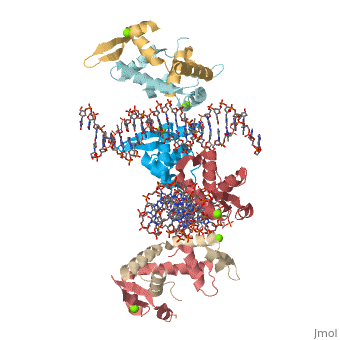2a07: Difference between revisions
No edit summary |
No edit summary |
||
| Line 2: | Line 2: | ||
===Crystal Structure of Foxp2 bound Specifically to DNA.=== | ===Crystal Structure of Foxp2 bound Specifically to DNA.=== | ||
{{ABSTRACT_PUBMED_16407075}} | {{ABSTRACT_PUBMED_16407075}} | ||
==Disease== | |||
[[http://www.uniprot.org/uniprot/FOXP2_HUMAN FOXP2_HUMAN]] Defects in FOXP2 are the cause of speech-language disorder 1 (SPCH1) [MIM:[http://omim.org/entry/602081 602081]]; also known as autosomal dominant speech and language disorder with orofacial dyspraxia. Affected individuals have a severe impairment in the selection and sequencing of fine orofacial movements, which are necessary for articulation. They also show deficits in several facets of language processing (such as the ability to break up words into their constituent phonemes) and grammatical skills.<ref>PMID:11586359</ref> Note=A chromosomal aberration involving FOXP2 is a cause of severe speech and language impairment. Translocation t(5;7)(q22;q31.2). | |||
==Function== | |||
[[http://www.uniprot.org/uniprot/FOXP2_HUMAN FOXP2_HUMAN]] Transcriptional repressor that may play a role in the specification and differentiation of lung epithelium. May also play a role in developing neural, gastrointestinal and cardiovascular tissues. Can act with CTBP1 to synergistically repress transcription but CTPBP1 is not essential. Involved in neural mechanisms mediating the development of speech and language. | |||
==About this Structure== | ==About this Structure== | ||
| Line 12: | Line 18: | ||
==Reference== | ==Reference== | ||
<ref group="xtra">PMID:016407075</ref><references group="xtra"/> | <ref group="xtra">PMID:016407075</ref><references group="xtra"/><references/> | ||
[[Category: Homo sapiens]] | [[Category: Homo sapiens]] | ||
[[Category: Bates, D L.]] | [[Category: Bates, D L.]] | ||
Revision as of 19:37, 24 March 2013
| |||||||||
| 2a07, resolution 1.90Å () | |||||||||
|---|---|---|---|---|---|---|---|---|---|
| Ligands: | |||||||||
| Gene: | FOXP2, CAGH44, TNRC10 (Homo sapiens) | ||||||||
| |||||||||
| |||||||||
| Resources: | FirstGlance, OCA, RCSB, PDBsum | ||||||||
| Coordinates: | save as pdb, mmCIF, xml | ||||||||
Crystal Structure of Foxp2 bound Specifically to DNA.Crystal Structure of Foxp2 bound Specifically to DNA.
Template:ABSTRACT PUBMED 16407075
DiseaseDisease
[FOXP2_HUMAN] Defects in FOXP2 are the cause of speech-language disorder 1 (SPCH1) [MIM:602081]; also known as autosomal dominant speech and language disorder with orofacial dyspraxia. Affected individuals have a severe impairment in the selection and sequencing of fine orofacial movements, which are necessary for articulation. They also show deficits in several facets of language processing (such as the ability to break up words into their constituent phonemes) and grammatical skills.[1] Note=A chromosomal aberration involving FOXP2 is a cause of severe speech and language impairment. Translocation t(5;7)(q22;q31.2).
FunctionFunction
[FOXP2_HUMAN] Transcriptional repressor that may play a role in the specification and differentiation of lung epithelium. May also play a role in developing neural, gastrointestinal and cardiovascular tissues. Can act with CTBP1 to synergistically repress transcription but CTPBP1 is not essential. Involved in neural mechanisms mediating the development of speech and language.
About this StructureAbout this Structure
2a07 is a 10 chain structure with sequence from Homo sapiens. Full crystallographic information is available from OCA.
See AlsoSee Also
ReferenceReference
- ↑ Stroud JC, Wu Y, Bates DL, Han A, Nowick K, Paabo S, Tong H, Chen L. Structure of the forkhead domain of FOXP2 bound to DNA. Structure. 2006 Jan;14(1):159-66. PMID:16407075 doi:10.1016/j.str.2005.10.005
- ↑ Lai CS, Fisher SE, Hurst JA, Vargha-Khadem F, Monaco AP. A forkhead-domain gene is mutated in a severe speech and language disorder. Nature. 2001 Oct 4;413(6855):519-23. PMID:11586359 doi:10.1038/35097076

